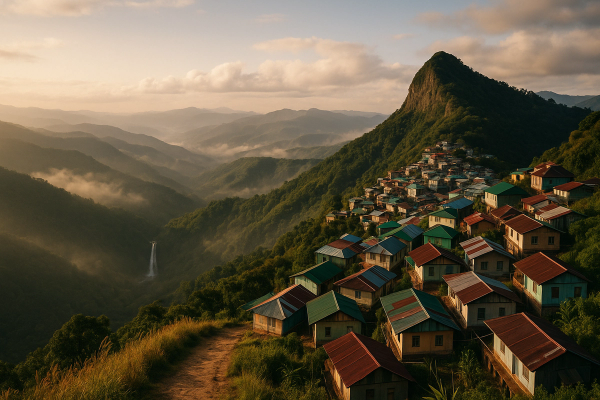Digital Nomad Guide for Indians: Top Countries & Visas 2025 — what actually worked for me#
So, uh, quick backstory. I left Bengaluru in Feb 2025 with a beat-up backpack, one semi-sane client, and too much chai in my system. Thought I’d do three months. It’s turned into… a whole thing. I spilled filter coffee on my trackpad in KL, got lost finding a VFS office in Lisbon (classic), and somehow learned the difference between a visa that lets you live like a nomad vs a visa that’ll get you in trouble if you try working from a cafe. This stuff is simple until it isn’t, you know.¶
Why 2025 is wild-good for Indian nomads#
Governments finally get it. Thailand rolled out the Destination Thailand Visa late 2024 that’s actually usable in 2025 for long stays (and remote workers who aren’t taking Thai jobs). Dubai’s remote work visa is still around, Malaysia’s DE Rantau is working smoother, Portugal and Spain are still letting remote folks base there with proper D visas. Meanwhile Japan and South Korea teased digital nomad/workation visas in 2024 but they only cover visa-waiver countries, not India, at least for now. And ETIAS in Europe is kicking off 2025-ish for visa-exempt travelers — not us — so Schengen rules are same-old for Indian passport holders. Which is both annoying and kinda familiar.¶
- Yes, visas are a pain. VFS slots can be a bloodsport in peak season. Book early.
- No, you can’t “just work” in countries on tourist visas if the local rules say don’t. Remote working from your laptop ≠ legal permission unless the visa allows it.
- Prices went up. Rents, taxes, even hostel beds. Nomad life isn’t dirt-cheap everywhere anymore.
Where I actually went and what I loved (and what was meh)#
I bounced through Malaysia, Thailand, UAE, Portugal, Spain, Estonia — plus shorter stays in Oman, Brazil, and a beach month in Costa Rica. I skipped Georgia this year even tho I love Tbilisi, just because the rules for Indian passports are a bit more fiddly now and there were protests in 2024 around that foreign agents law. Friends said it’s fine for tourists but I wasn’t up for surprises. Here’s the real tea, country by country, with visa bits that matter for us:¶
Malaysia — DE Rantau Nomad Pass (my unexpected favorite)#
Kuala Lumpur hooked me. The DE Rantau Nomad Pass is a proper digital nomad pass supported by MDEC, typically 12 months and renewable, and Indian citizens can apply. You need proof of stable remote income (around USD 24k annually has been the benchmark) and client contracts. Processing was 6–8 weeks for me and the online portal didn’t break even once, which feels rare. I stayed in Bangsar South and then Bukit Bintang — service apartments in 2025 are about RM 2,000–3,500 per month for a decent studio with a gym. Coworking monthly passes were RM 400–600. Wifi is like, fast-fast. I did calls from the Colony cowork space and ate way too much nasi lemak. KL also has real Indian groceries so you don’t cry. Bonus: Penang and Langkawi are part of the DE Rantau hubs too, and beach days are ridiculously easy.¶
Thailand — Destination Thailand Visa (DTV) + Chiang Mai magic#
So DTV launched late 2024 and in 2025 it’s finally usable. It’s a five-year multiple-entry visa letting you stay up to 180 days per entry, meant for long-stay folks like remote workers, but you must not take Thai employment. Indians can apply via Thai e-visa or consulate. You need to show funds and travel insurance; fee is around 10,000 THB. I did 3 months in Chiang Mai — Nimman area — and paid THB 18,000 for a one-bed with a balcony and more plants than I can keep alive. Coworking membership around THB 2,500–3,500. Street food still silly-cheap. Really important: do not overstay. Immigration is strict about the exact days, and 2025 enforcement is tighter. Oh, and if you’re tempted by Thailand’s tax residency stuff — just be aware once you cross 180 days in a year, the tax rules can kick in, so plan around your dates.¶
UAE (Dubai) — Remote Work Visa that actually feels premium#
Dubai’s one-year remote work visa (Virtual Work Program) is still a solid option for Indian passports. I had to show minimum monthly income (USD 3,500), health insurance, valid passport. Processing took about 3 weeks for me in early 2025. JLT and Dubai Marina are nomad magnets — I paid AED 5,800 for a furnished studio near the metro. Coworking membership AED 700–900. 5G speeds are insane, safety is top tier, and the coffee’s expensive but actually good. Taxes are a non-issue for most remote folks here as long as you aren’t earning UAE-source income. Heat in May? Oh boy. Don’t try walking at noon unless you want to melt.¶
Portugal — D8 (remote work) visa, still dreamy, just… bureaucracy#
Portugal’s D8 visa for remote workers is alive in 2025. Income requirement is typically around 4x monthly minimum wage, which puts it roughly in the €3,300–€3,600 per month range, give or take. Indians apply via VFS in India for the national visa, then convert to residence with AIMA in Portugal. It took me about 10 weeks all-in; AIMA appointments are less chaotic now than 2023, but you still need patience. Lisbon rents… not cheap anymore. I paid €1,350 for a small studio in Arroios; Porto was a bit saner at €1,100. Coworking monthly €120–200. Trams are beautiful, pickpockets exist, sunsets at Miradouro da Senhora do Monte can make you forget the paperwork pain. I thought it’d be cheap-cheap; it’s not. Still worth it if you love slow city life and pasteis and seaside weekends.¶
Spain — Digital Nomad Visa, late nights and better tapas than your dreams#
Spain launched their digital nomad visa in 2023 and it’s rolling steady in 2025. For Indians, you apply at the Spanish consulate. Income requirements hover around 200% of IPREM for the main applicant — many folks are being asked for roughly €2,500–€2,700 per month now — and proof of remote work plus qualifications or experience. I did Barcelona for 2 months and Madrid for 1. Rent in BCN for a decent 1-bed was €1,550 near Poblenou (beach-adjacent, which I loved). Coworking €180–250 monthly. Tapas: unfairly good. I got pickpocketed once on the metro because me and him were both distracted and honestly I should’ve known — keep bags zipped tight. Upside: healthcare is great, which matters if you’re clumsy like me.¶
Estonia — D-visa for digital nomads, ultra-online society#
Estonia’s digital nomad D-visa is clean and sensible. For 2025, you still need to show remote income at a higher threshold — historically around €4,500 gross per month. Indian citizens apply at an embassy or visa center. Tallinn winters are a mood — cold as heck — but the digital infrastructure makes everything easier. My rent was €800 for a minimalist studio near Kalamaja. Coworking around €120. I loved the e-Residency perks for business admin, even though that’s separate from the visa itself. Saunas are life.¶
Brazil — Digital Nomad Visa (VITEM), samba meets spreadsheets#
Brazil’s digital nomad visa has been actually doable for Indians since it launched. Requirements are usually proof of remote income (commonly quoted around USD 1,500 per month or savings ~USD 18,000), health insurance, clean background. Apply through the consulate with online forms. I did a month in Florianópolis and 2 weeks in São Paulo. Rent in Floripa for a beachy apartment was BRL 4,000. In SP, expect BRL 4,500–5,500 for central areas. Wifi was solid, food is dangerously tasty, and you should avoid flashing phones in crowded places at night. I learned a few dance steps I absolutely cannot repeat in public.¶
Costa Rica — Remote Worker Visa, pura vida actually fits nomads#
Costa Rica’s digital nomad visa lets you stay longer without the constant visa-runs. They ask for income proof (USD 3,000 monthly solo / USD 4,000 with family), health insurance, and you can apply online. I did Santa Teresa — surf before standups. Rents in 2025 for a 1-bed near the beach were USD 1,200–1,600 monthly. Coworking passes USD 150–250. Rainy season can blow up your plans, so route calls around afternoon storms. Also mosquitoes are the real overlords. Pack spray.¶
Oman — newish Digital Nomad Visa vibes, Muscat is calm-calm#
Oman introduced a remote work visa recently and in 2025 it’s a quieter, less-hyped option. Indians can apply online; expect to show steady income (commonly around USD 3,000 monthly is mentioned), health insurance, and background docs. I stopped in Muscat for three weeks on the way to Dubai. The coastline is ridiculous — empty beaches, mountains, frankincense shops that smell like temples. I paid 300 OMR for a furnished place outside the center; coworking was 60–80 OMR a month. Uber-ish options exist, but renting a car is easier. It’s safe, conservative, and very relaxed — don’t underdress in malls.¶
Mauritius & Seychelles — beachy long stays that aren’t fantasy#
Mauritius has the Premium Visa (up to a year) — Indians can apply online. No hard income number, but you must show funds, onward ticket, and health insurance. I stayed on the west coast — Flic-en-Flac — for a month. Rents were MUR 30,000–45,000 for decent apartments; coworking around MUR 8,000–10,000. Very liveable. Seychelles has a Workcation program for remote workers too: Indians eligible, but lodging is pricier — many places start €1,200+ monthly unless you find a shared villa. Great scuba, average internet on some islands. I blew a whole week snorkeling instead of finishing a client deck. Worth it? Um, yes.¶
What I wish I knew before I queued at VFS for the 100th time#
- Schengen for Indians is still a standard visa, not ETIAS. Appointments for Spain/Portugal can be scarce in summer 2025 — book 2–3 months before.
- Thailand DTV is real but not a work permit. Don’t freelance for Thai clients while on DTV.
- Dubai remote work visa needs health insurance that explicitly covers the UAE.
- Portugal tax breaks changed a lot; the old NHR scheme got replaced. If you plan to become tax resident, get advice first.
- Bali introduced a tourist levy in 2024 (IDR 150k) and 2025 enforcement is serious about foreigners working illegally. Indonesia’s promised nomad visa still isn’t truly launched, so stay within tourist rules.
- Japan and South Korea’s nomad/workation visas in 2024/5 mostly exclude Indian passport holders for now. Sad but true.¶
Money, wifi, and finding a bed you actually like#
Prices I paid or saw in 2025, just to set expectations:
- Kuala Lumpur: RM 2,000–3,500 for studios; coworking RM 400–600; coffee RM 10–15.
- Chiang Mai: THB 12,000–22,000 apartments; coworking THB 2,500–3,500.
- Dubai: AED 4,500–7,000 studios in JLT/Marina; coworking AED 700–900.
- Lisbon: €1,100–1,600 studios; coworking €120–200; pastel de nata €1.2.
- Barcelona: €1,300–1,900 for central 1-bed; coworking €180–250.
- Tallinn: €700–900 studio; coworking €100–150.
- Florianópolis/São Paulo: BRL 3,500–5,500; coworking BRL 400–700.
- Santa Teresa (Costa Rica): USD 1,000–1,500; coworking USD 150–250.
- Muscat: 250–350 OMR apartments; coworking 60–80 OMR.
- Mauritius: MUR 30k–50k; coworking MUR 8k–10k.
Get an eSIM (Airalo or Nomad) and then grab local SIMs for heavy data — Telkomsel in Indonesia, AIS in Thailand, U-Mobile in Malaysia were solid for me. In Spain/Portugal, home fiber is dreamy if your landlord actually calls the provider like they promised, otherwise you wait. I waited. A lot.¶
Safety notes I wont sugarcoat (2025 edition)#
Barcelona and Lisbon: pickpockets are an art form. Zip your bag, keep phones front-facing, never hang it on a chair. Costa Rica: peaceful, but don’t leave stuff in cars at beach lots. Brazil: city centers at night — stick to lit areas and don’t flash tech. Oman, UAE, Mauritius: felt super safe. Thailand: very chill, but watch out for motorbike scams and some bars pushing weird bills. Georgia: friends reported protests in 2024 were mostly focused on politics, tourists were fine, but always check current advisories. Heatwaves across Europe are legit — summer 2025 had hot spells again, plan AC and water. And seriously, travel insurance. I used mine twice this year — once for a fractured toe in KL, once for a stolen bag drama in BCN.¶
Okay, but what visas are Top for Indians right now?#
- Malaysia DE Rantau Nomad Pass: 12 months, renewable, Indian citizens eligible, proof of remote income and client contracts.
- Thailand DTV: 180-day stays per entry, multiple entries up to 5 years, not a work permit, Indians apply via consulate/e-visa.
- UAE Dubai Remote Work Visa: one year, income ~USD 3,500 monthly, health insurance mandatory.
- Portugal D8: remote worker residence, income roughly €3,300–€3,600/month, apply via VFS India.
- Spain Digital Nomad Visa: income around €2,500–€2,700/month, remote contract and qualifications/experience.
- Estonia Digital Nomad D-visa: income threshold around €4,500 gross/month.
- Brazil Nomad Visa (VITEM): income commonly ~USD 1,500/month or savings; Indians eligible.
- Costa Rica Remote Worker Visa: USD 3,000 solo / USD 4,000 family; online application.
- Oman Remote Work Visa: 1-year style visa, income around USD 3,000 monthly, online.
- Mauritius Premium Visa: up to 1 year, proof of funds and accommodation, Indians eligible.
- Seychelles Workcation Program: up to 1 year, proof of funds and insurance, Indians eligible.
Always cross-check numbers on official sites because they tweak them. I saw Portugal’s and Spain’s income thresholds nudged in early 2025 for some applicants.¶
What I actually did wrong (so you can not do it)#
I booked a VFS slot for the wrong city in India. Don’t laugh. The reschedule window wasn’t friendly. Also, I assumed I’d get a bank account in Portugal in one day — lol no, it took a week and a lot of “come back tomorrow.” I nearly overstayed in Thailand because I miscounted days with a border run. Bring a calendar, set alarms. In Dubai, I thought my travel insurance would cut it — nope, they required UAE coverage specifics. I once tried to work from a beach palapa during rainy season in Costa Rica and my laptop legit fogged up. The cloud wasn’t a metaphor.¶
Little moments that made it worth it#
A Malay auntie in Petaling Street handed me tissues when I nearly cried over a client delay. A barista in Barcelona gave me a free cortado after I got pickpocketed and refused to let me pay. A surfer in Santa Teresa told me to paddle out even if I was scared — I did, and it was the best morning of the year. In Muscat, a taxi driver detoured to show me his favorite viewpoint, didn’t charge. In Tallinn, a sauna stranger taught me how to breathe through cold plunges. Nomad life isn’t perfect, but the kindness shows up when you least expect it.¶
Would I do it again in 2025/26?#
Absolutely. With caveats. Budget more than you think. Lock visas early. Respect local rules — don’t be that person streaming from a cafe and calling it “employment” on a tourist stamp. For Indians, the best mix right now is Malaysia + Thailand + UAE for Asia, plus Portugal/Spain/Estonia for Europe if you’re up for paperwork. Brazil and Costa Rica if you want that beach-meets-remote groove. Oman, Mauritius, Seychelles for quiet long stays. Georgia if you’re willing to read up on the latest entry notes and do the right visa. And carry a spare laptop keyboard. Learned the hard way.¶
If you want more candid stories and updated destination tips, I keep poking around AllBlogs.in for other travelers’ takes — it’s messy in a good way and honestly helped me decide my next hop.¶














